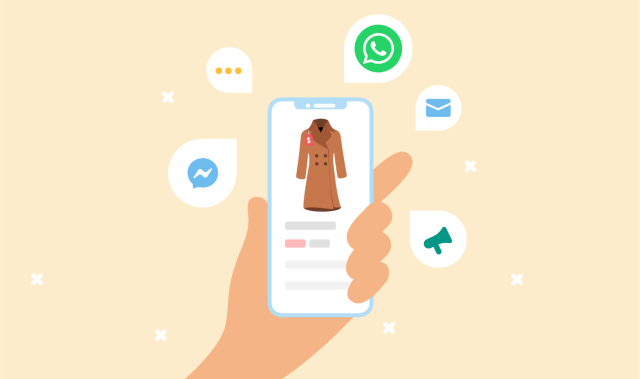In this article:
- What is mobile marketing?
- What are the different types of mobile marketing campaigns?
-
Examples of mobile marketing campaigns done right
- 1. SMS marketing: Nissan
- 2. Geofencing: GasBuddy
- 3. Location-based roadside assistance: AAA
- 4. Push notifications: Duolingo
- 5. Strategic partnerships: RXBAR x Spotify
- 6. Holiday shopping: Picard
- 7. Opt-in campaign: Vail Resort
- 8. QR codes: Snickers
- 9. Augmented reality (AR): Cheetos
- 10. Mobile messaging + AI chatbot integration: Intermarché
- Get started with mobile marketing
Digital marketing has, for many, become mobile marketing. More and more people complete the majority of their online activities on their phones, and that means that mobile marketing needs to occupy a strong percentage of your efforts to reach, engage, and convert customers and prospects.
How widespread has mobile usage become? Over a five-year period ending in 2022, the percent of internet usage coming from mobile devices rose from 51.5% to 59.1%. And in 2021, 73% of e-commerce sales came from mobile devices. In other words, more people are online using smartphones, and more of them shop from their devices as well.
As a marketer, you have to go where the people are. With that in mind, let’s celebrate some great examples of mobile marketing campaigns to inspire you as you add new campaigns to your lineup.
What is mobile marketing?
Mobile marketing refers to any type of marketing activity that’s optimized for mobile devices. This is distinct from responsive or mobile-friendly websites — that’s a given. Mobile advertising campaigns are designed for mobile technology such as push notifications, apps, popup forms, SMS and MMS, and mobile-optimized ad formats. Mobile marketing can take advantage of the touchscreen feature of mobile devices. You can implement conversational marketing and interact with the customer in real time.
Because it seems like people check their phones about as often as they take a breath, mobile marketing strategies that are personalized to subscribers tend to be seen very quickly. Mobile ad campaigns can also leverage location data to deliver hyper-individual marketing campaigns. All these efforts lead to higher customer engagement, which generates more sales and stronger customer retention, as you’re about to see.
What are the different types of mobile marketing campaigns?
Though the methods and technology may be different, the goals of the different types of mobile marketing campaigns you’re about to see will feel very familiar. Marketing is marketing. You want customers, leads, sales, list growth, and revenue. Mobile simply offers a new way to hit your targets.
Some of the most effective mobile marketing campaigns are built upon goals like:
-
Raising brand awareness: Mobile advertising enables your brand to break into new markets with targeted brand awareness campaigns by showing up in front of your target audience on their devices.
-
Retaining customers: Mobile marketing allows you to remain top of mind and continue to sell and resell to your existing customers. They know you, trust you, and like you. And with consistent mobile advertising, they won’t forget about you.
-
Gaining opt-in requests: With mobile marketing, you can grow your email and SMS lists using all sorts of opt-in forms that are easy to navigate on the go. You can funnel people to your opt-in forms from social media, your website, email, and SMS marketing.
-
Collecting feedback: Getting testimonials, reviews, and customer feedback is also easy on mobile, because people are used to texting on their devices, and leaving feedback uses the same, familiar technology.
-
Upsells and cross-sells: When someone makes a purchase from your website using their mobile device, you can offer upsells and cross-sells with popup messages and other notifications that are easy to understand and act on.
-
Running referral campaigns: Your customers can easily refer their friends and colleagues on mobile devices, so this has become another effective use of mobile advertising.
Examples of mobile marketing campaigns done right
Now comes the fun part. We’re going to look at ten successful mobile marketing examples, many of which are omnichannel campaigns. This means that they used a variety of channels (including mobile) to adequately meet their audience throughout the various steps in their journey.
1. SMS marketing: Nissan
What’s better than selling a car to a new customer? Selling them a second car when they’re done with the first.
This is a big challenge for every car company because most people don’t buy cars very often. When they do, their life situation has often changed, which necessitates a different type of car.
Nissan found the solution to the customer loyalty challenge in the form of a Rich SMS mobile marketing campaign, created through Sinch and Adobe. Using personalized data about each customer and the Nissan they purchased the first time around, the carmaker began sending Rich SMS messages to customers to keep a stronger connection with them throughout their ownership experience.
They sent messages about upcoming maintenance, weather-related topics, features in the car the owner hadn’t yet utilized, and various other topics. The result? Four times as much customer engagement and much higher conversions. By continuing this highly personalized SMS marketing strategy, they anticipate strong growth in repeat buyers.
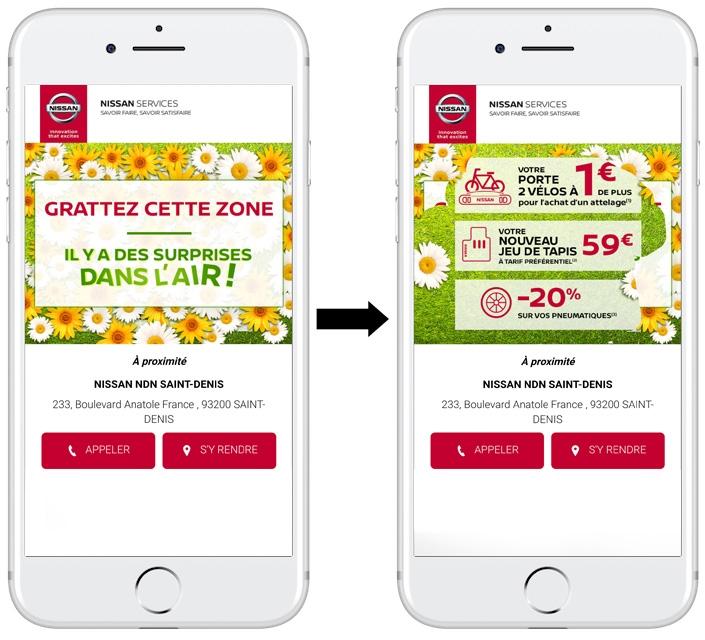
Example of how Nissan Europe uses Rich SMS to send customers hyper-personalized reminders and offers.
2. Geofencing: GasBuddy
When there’s a gas shortage, who ya gonna call? In 2021, the answer was GasBuddy. The GasBuddy app took over the number one spot for the most used app after the hack of a major U.S. pipeline, in part because of its easy user experience and timely, personalized information.
But the app was around well before that, offering location-based information to its users when they wanted to find the lowest-priced gas stations in their vicinity. In 2021, after the hack, the app added the capability to tell users which stations still had gas, because people panicked, and numerous gas stations ran out completely.
The app uses geolocation data to deliver regionally personalized information to each of its mobile users.
3. Location-based roadside assistance: AAA
This example of mobile marketing is a classic story of an old business encountering new technology and finding a way to adapt.
AAA has been around for over 120 years. For many of those years, they offered their toll-free helpline for roadside assistance. It worked well, and customers loved it whenever they had car trouble. The problem came when AAA discovered people were texting that number instead of calling it. And since that number was established before texting even existed, none of those texts were getting through. That meant lots of customers weren’t getting the help they needed.
So, AAA teamed up with Sinch to reconfigure their help line so it could receive SMS messages. Now, when people text this number, they receive an automated message from AAA that gives them a link to request roadside assistance, bypassing the need to even speak to an agent. This feature is now used to help thousands of people, and because agents now spend less time on roadside assistance, they can spend more time on the customer interactions that require more hands-on care.
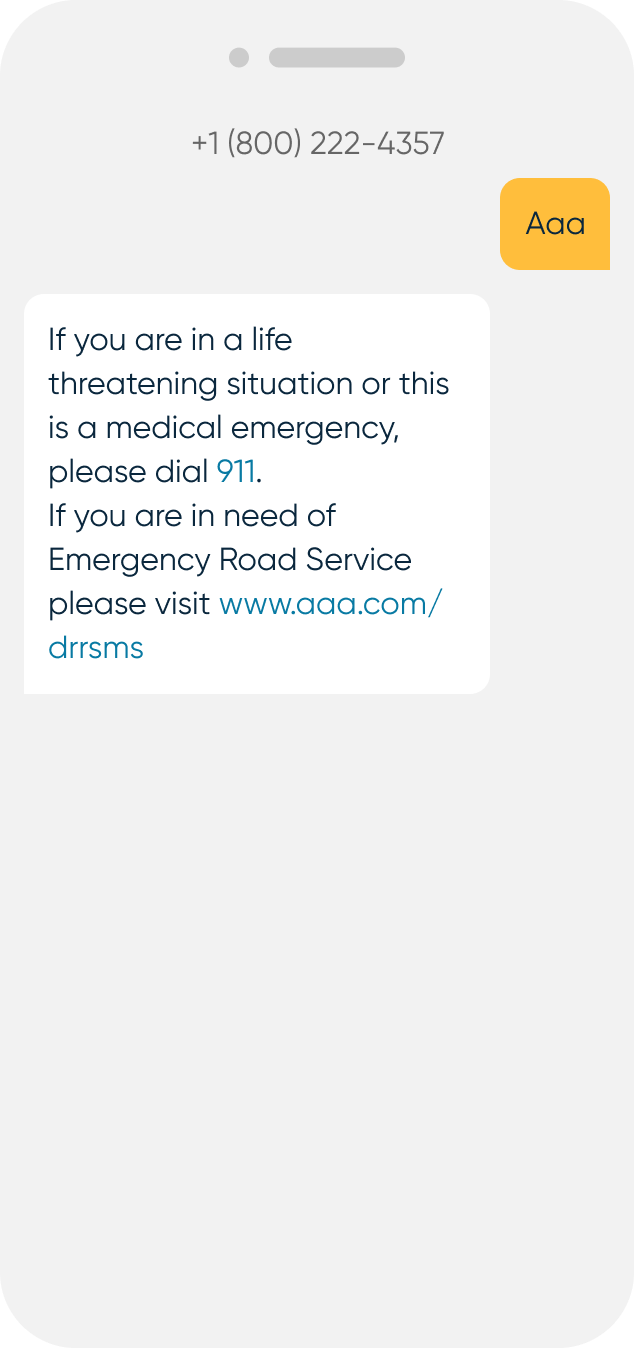
Since mid-2000, AAA's 800-HELP number has been text-enabled so the user can create a request for roadside assistance without having to speak to an AAA agent.
4. Push notifications: Duolingo
In a true omnichannel campaign masterclass, language-learning app Duolingo created a hilarious April Fool’s Day mobile advertising campaign to drum up brand awareness and also increase usage of their service by existing customers.
Part of Duolingo’s mobile marketing strategy is to send push notifications that remind their mobile users to practice their language learning lessons for the day. They also have a green owl mascot named Duo who has developed a bit of a stalker reputation for showing up in all their notifications (all in good fun). So in 2019, they launched a fake marketing campaign claiming that Duo would show up – in person – to notify the app’s users to practice their language lessons.
The campaign included a very funny video showing this actually happening to users, with Duo interrupting people at work, on dates, and various other places. Duolingo promoted this video and the campaign on YouTube, then-Twitter, Facebook, and Instagram, and on April 1st, it went viral, resulting in record-setting numbers of users, daily active users, and revenue.
Building on that success, Duolingo continues drumming up creative ways to exploit their reputation as a heavy sender of push notifications, including “the unignorable notification” campaign.
5. Strategic partnerships: RXBAR x Spotify
Can you do mobile advertising even if you don’t have an app? RXBAR did, partnering with Spotify and rapper/actor Ice-T to create a brand awareness in-app campaign that ran for Spotify’s millions of music listeners.
The campaign leveraged multiple examples of mobile marketing, including mobile and desktop overlay, audio everywhere, video takeover, sponsored sessions, and homepage takeover. RXBAR also used Spotify’s audience data to send targeted ads to fitness enthusiasts and commuters while they listened.
The campaign led to a 243% lift in ad recall, a 42% lift in brand awareness, and a 52% increase in association of their tagline with their brand.
6. Holiday shopping: Picard
Can you create your holiday meal plan with help from your grocer? French frozen food company Picard created an interactive mobile experience to do just that.
They used RCS (Rich Communication Services) to allow their prospects to build their own holiday meal plan, including factors such as dietary preferences, budget, and interest level in cooking. Because the conversational messaging technology of RCS is only compatible with Android phones, Picard also developed a Rich SMS campaign, and they were able to compare the results.
The interactive RCS campaign saw three times the click rate of the Rich SMS campaign, 42% higher engagement – from a smaller audience – and 10% more website redirections. It was an effective campaign that used multiple channels to run an A/B test while also growing brand awareness and boosting sales and customer engagement.
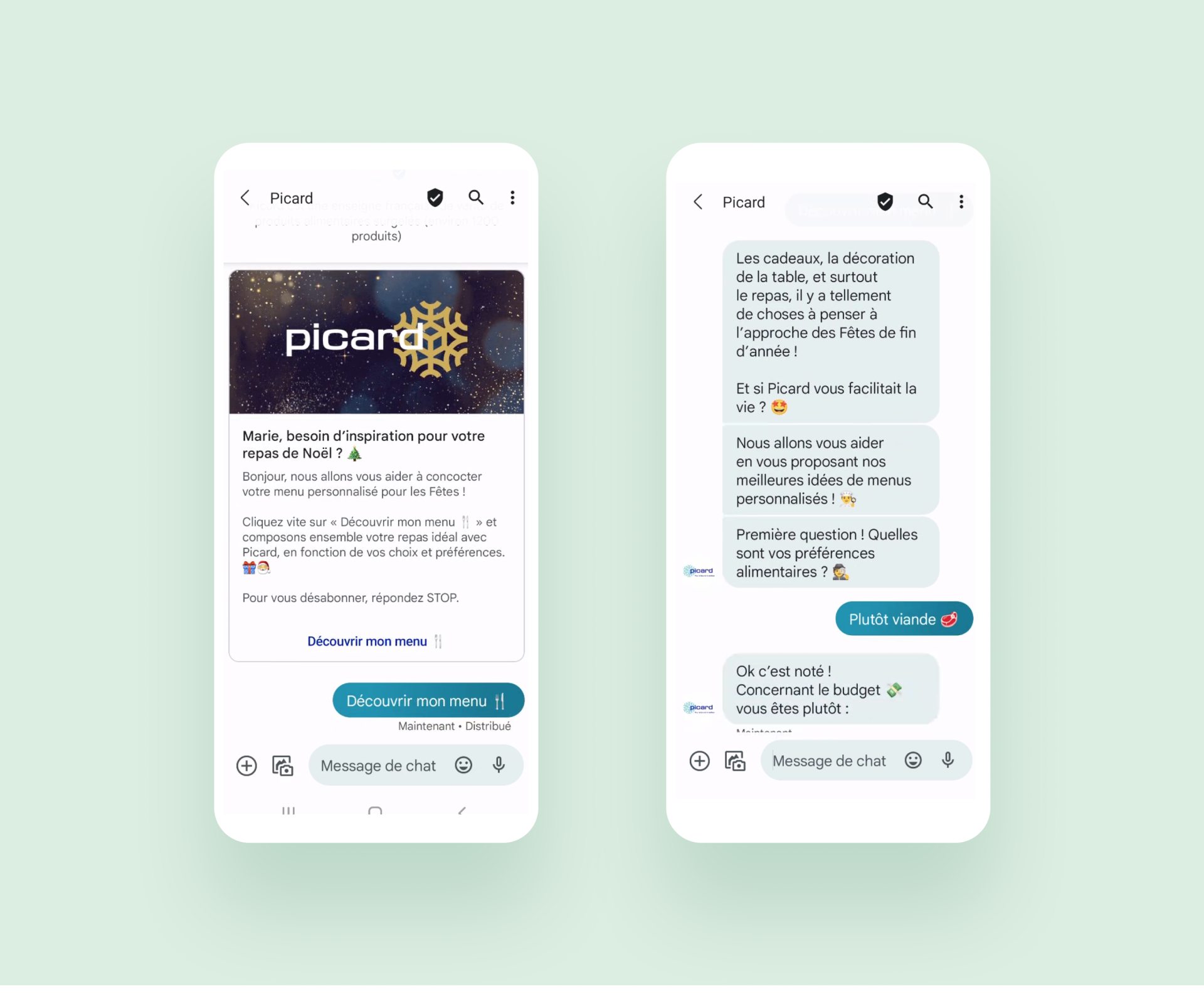
Picard built a conversational mobile marketing experience tailored to holiday menu creation, taking into account things like dietary preferences and budget.
7. Opt-in campaign: Vail Resort
A world-renowned ski destination, Vail Resort found it was missing an opportunity to connect more personally with guests through their mobile devices.
They revamped their opt-in process and connected their customer data from Adobe Campaign with Sinch’s SMS and marketing programs so they could begin sending personalized text message ad campaigns. Before, they might send out anonymous weather updates. Now, customers also receive relevant offers and information they want to know via their mobile phones.
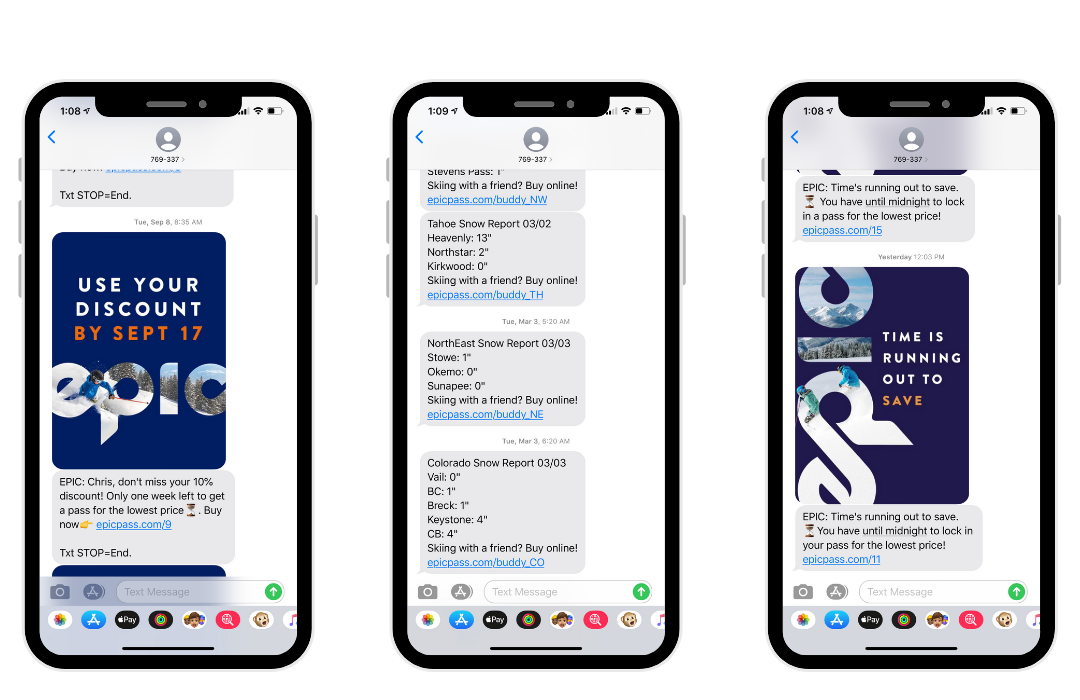
Vail Resorts created an opt-in mobile marketing campaign with personalized, useful information for guests.
Their new emphasis on delivering a better mobile experience has led to increased engagement and conversions.
8. QR codes: Snickers
Getting customers to submit their own content is a great way to increase brand loyalty and reach wider audiences. Snickers, the official chocolate bar of the NFL, has launched a new version of their “Rookie Mistake of the Year” program, in which football fans can send in videos, photos, or written versions of small embarrassing errors they’ve made. NFL players will then judge the winners, with a grand prize of Super Bowl tickets.
By putting a QR code right on the packaging, Snickers made it easy for customers to use their mobile phones to share their stories. Later in the year, the QR code also unlocked an augmented reality program featuring NFL wide receiver Stefon Diggs.
9. Augmented reality (AR): Cheetos
Cheetos wanted to make a big impression with their Super Bowl commercial. Using augmented reality technology, they made it possible to scan any part of their “Snap to Steal” commercial using the Snapchat app. When a customer did this, a hand showed up onscreen and appeared to take a bag of new Cheetos Crunch Pop Mix right out of the commercial. Then, smartphone users just had to click the bag, and they got a coupon for a free bag of Cheetos.
Over 50,000 coupons were claimed, and the buzz generated on multiple social media platforms led researchers to confirm that many more people went out and bought bags, even if they didn’t get a free one.
10. Mobile messaging + AI chatbot integration: Intermarché
French supermarket chain Intermarché was looking for a way to enhance the customer experience. They turned to Sinch, and developed a recipe generating bot that shoppers could use right in the store on their mobile devices.
The link to the generator was offered in their e-newsletter, and customers could click through to access the bot and use its conversational AI interface to make shopping more fun and spontaneous. Intermarché earned a 59% customer engagement rate, and got a lot of attention in a competitive industry for innovating and elevating a shopping experience that often feels like a chore.
They also began using Sinch’s Rich SMS service to develop fun and creative ways of promoting their loyalty program and drive-thru service, including a game customers could play while shopping.
Get started with mobile marketing
Pretty cool stuff, right?
These examples demonstrate different ways to use mobile marketing campaigns that do what no other form of marketing can – engage customers right in the middle of the shopping experience, or right from the packaging, on their mobile devices.
You can see how mobile marketing offers numerous ways to use timeliness and location targeting to deliver an experience that can’t be easily replicated by competitors. And the biggest reason these campaigns work is because they engage potential customers on marketing channels they already use, such as SMS, social media, and mobile apps.
If you want to learn more but aren’t sure where to start, here’s a guide to SMS marketing.
And if these ad campaigns have opened your eyes about developing mobile marketing efforts for your company, let’s chat. Our team is excited to talk about conversational marketing with you!
